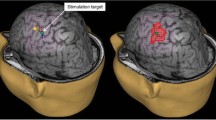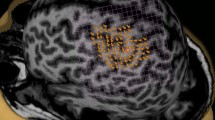Abstract
Low-frequency repetitive transcranial magnetic stimulation (rTMS) can exert local and inter-hemispheric neuromodulatory effects on cortical excitability. These physiologic effects can translate into changes in motor behavior, and may offer valuable therapeutic interventions in recovery from stroke. Neuronavigated TMS can maximize accurate and consistent targeting of a given cortical region, but is a lot more involved that conventional TMS. We aimed to assess whether neuronavigation enhances the physiologic and behavioral effects of low-frequency rTMS. Ten healthy subjects underwent two experimental sessions during which they received 1600 pulses of either navigated or non-navigated 1 Hz rTMS at 90% of the resting motor threshold (RMT) intensity over the motor cortical representation for left first dorsal interosseous (FDI) muscle. We compared the effects of navigated and non-navigated rTMS on motor-evoked potentials (MEPs) to single-pulse TMS, intracortical inhibition (ICI) and intracortical facilitation (ICF) by paired-pulse TMS, and performance in various behavioral tasks (index finger tapping, simple reaction time and grip strength tasks). Following navigated rTMS, the amplitude of MEPs elicited from the contralateral (unstimulated) motor cortex was significantly increased, and was associated with an increase in ICF and a trend to decrease in ICI. In contrast, non-navigated rTMS elicited nonsignificant changes, most prominently ipsilateral to rTMS. Behaviorally, navigated rTMS significantly improved reaction time RT and pinch force with the hand ipsilateral to stimulation. Non-navigated rTMS lead to similar behavioral trends, although the effects did not reach significance. In summary, navigated rTMS leads to more robust modulation of the contralateral (unstimulated) hemisphere resulting in physiologic and behavioral effects. Our findings highlight the spatial specificity of inter-hemispheric TMS effects, illustrate the superiority of navigated rTMS for certain applications, and have implications for therapeutic applications of rTMS.






Similar content being viewed by others
References
Avanzino L, Bove M, Trompetto C, Tacchino A, Ogliastro C, Abbruzzese G (2008) 1-Hz repetitive TMS over ipsilateral motor cortex influences the performance of sequential finger movements of different complexity. Eur J Neurosci 27:1285–1291
Bagnato S, Currà A, Modugno N, Gilio F, Quartarone A, Rizzo V, Girlanda P, Inghillieri M, Berardelli A (2005) One-hertz subthreshold TMS increases the threshold for evoking inhibition in the human motor cortex. Exp Brain Res 160:368–374
Barker AT, Jalinous R, Freeston IL (1985) Non-invasive magnetic stimulation of human motor cortex. Lancet 1:1106–1107
Bernad DM, Doyon J (2008) The role of noninvasive techniques in stroke therapy. Int J Biomed Imaging 2008:672582
Boroojerdi B, Kopylev L, Battaglia F, Facchini S, Ziemann U, Muellbacher W, Cohen LG (2000) Reproducibility of intracortical inhibition and facilitation using the paired-pulse paradigm. Muscle Nerve 23:1594–1597
Chen R, Cros D, Curra A, Di Lazzaro V, Lefaucheur JP, Magistris MR, Mills K, Rosler KM, Triggs WJ, Ugawa Y, Ziemann U (2008) The clinical diagnostic utility of transcranial magnetic stimulation: report of an IFCN committee. Clin Neurophysiol 119:504–532
Devanne H, Lavoie BA, Capaday C (1997) Input-output properties and gain changes in the human corticospinal pathway. Exp Brain Res 114:329–338
Di Lazzaro V, Oliviero A, Profice P, Pennisi MA, Pilato F, Zito G, Dileone M, Nicoletti R, Pasqualetti P, Tonali PA (2003) Ketamine increases motor cortex excitability to transcranial magnetic stimulation. J Physiol 547:485–496
Fitzgerald PB, Brown TL, Daskalakis ZJ, Chen R, Kulkarni J (2002) Intensity-dependent effects of 1 Hz rTMS on human corticospinal excitability. Clin Neurophysiol 113:1136–1141
Gilio F, Rizzo V, Siebner HR, Rothwell JC (2003) Effects on the right motor hand-area excitability produced by low-frequency rTMS over human contralateral homologous cortex. J Physiol 551:563–573
Gugino LD, Romero JR, Aglio L, Titone D, Ramirez M, Pascual-Leone A, Grimson E, Weisenfeld N, Kikinis R, Shenton ME (2001) Transcranial magnetic stimulation coregistered with MRI: a comparison of a guided versus blind stimulation technique and its effect on evoked compound muscle action potentials. Clin Neurophysiol 112:1781–1792
Hammond G, Faulkner D, Byrnes M, Mastaglia F, Thickbroom G (2004) Transcranial magnetic stimulation reveals asymmetrical efficacy of intracortical circuits in primary motor cortex. Exp Brain Res 155:19–23
Hannula H, Ylioja S, Pertovaara A, Korvenoja A, Ruohonen J, Ilmoniemi RJ, Carlson S (2005) Somatotopic blocking of sensation with navigated transcranial magnetic stimulation of the primary somatosensory cortex. Hum Brain Mapp 26:100–109
Heide G, Witte OW, Ziemann U (2006) Physiology of modulation of motor cortex excitability by low-frequency suprathreshold repetitive transcranial magnetic stimulation. Exp Brain Res 171:26–34
Hummel F, Cohen LG (2005) Improvement of motor function with noninvasive cortical stimulation in a patient with chronic stroke. Neurorehab Neural Re 19(1):14–19
Julkunen P, Jauhiainen AM, Westerén-Punnonen S, Pirinen E, Soininen H, Könönen M, Pääkkönen A, Määttä S, Karhu J (2008a) Navigated TMS combined with EEG in mild cognitive impairment and Alzheimer’s disease: a pilot study. J Neurosci Methods 172:270–276
Julkunen P, Paakkonen A, Hukkanen T, Kononen M, Tiihonen P, Vanhatalo S, Karhu J (2008b) Efficient reduction of stimulus artefact in TMS-EEG by epithelial short-circuiting by mini-punctures. Clin Neurophysiol 119:475–481
Kathleen YH, Sydney Y, Schaefer RT, Knight JA, Alvaro M, Joseph S, Robert LS (2009) Ipsilesional trajectory control is related to contralesional arm paralysis after left hemisphere damage. Exp Brain Res 196(2):195–204
Kiers L, Cros D, Chiappa KH, Fang J (1998) Variability of motor potentials evoked by transcranial magnetic stimulation. Electroencephalogr Clin Neurophysiol 89:415–423
Kobayashi M, Pascual-Leone A (2003) Transcranial magnetic stimulation in neurology. Lancet Neurol 2:145–156
Kobayashi M, Hutchinson S, Schlaug G, Pascual-Leone A (2003) Ipsilateral motor cortex activation on functional magnetic resonance imaging during unilateral hand movements is related to interhemispheric interactions. Neuroimage 20:2259–2270
Kujirai T, Caramia MD, Rothwell JC, Day BL, Thompson PD, Ferbert A, Wroe S, Asselman P, Marsden CD (1993) Corticocortical inhibition in human motor cortex. J Physiol 471:501–519
Mansur CG, Fregni F, Boggio PS (2005) A sham stimulation-controlled trial of rTMS of the unaffected hemisphere in stroke patients. Neurology 64:1802–1804
Mathiowetz V, Weber K, Volland G, Kashman N (1984) Reliability and validity of grip and pinch strength evaluations. J Hand Surg Am 9(2):222–226
Muellbacher W, Ziemann U, Boroojerdi B, Hallett M (2000) Effects of low-frequency transcranial magnetic stimulation on motor excitability and basic motor behavior. Clin Neurophysiol 111:1002–1007
Noirhomme Q, Ferrant M, Vandermeeren Y, Olivier E, Macq B, Cuisenaire O (2004) Registration and real-time visualization of transcranial magnetic stimulation with 3-D MR images. IEEE Trans Biomed Eng 51:1994–2005
Oldfield RC (1971) The assessment and analysis of handedness: the Edinburgh inventory. Neuropsychologia 9:97–113
Pascual-Leone A, Tormos JM, Keenan J, Tarazona F, Canete C, Catala MD (1998) Study and modulation of human cortical excitability with transcranial magnetic stimulation. J Clin Neurophysiol 15:333–343 (Review)
Paus T, Jech R, Thompson CJ, Comeaur R, Peters T, Evans AC (1998) Dose-dependent reduction of cerebral blood flow during rapid-rate transcranial magnetic stimulation of the human sensorimotor cortex. J Neurophysiol 79:1102–1107
Plewnia C, Lotze M, Gerloff C (2003) Disinhibition of the contralateral motor cortex by low-frequency rTMS. Neuroreport 14:609–612
Rösler KM, Roth DM, Magistris MR (2008) Trial-to-trial size variability of motor-evoked potentials. A study using the triple stimulation technique, Exp Brain Res 187:51–59
Rossi S, Hallett M, Rossini PM, Pascual-Leone A (2009) Safety of TMS Consensus Group. Safety, ethical considerations, and application guidelines for the use of transcranial magnetic stimulation in clinical practice and research. Clin Neurophysiol 120(12):2008–2039
Rossini PM, Barker AT, Berardelli A, Caramia MD, Caruso G, Cracco RQ, Dimitrijevic MR, Hallett M, Katayama Y, Lucking CH (1994) Non-invasive electrical and magnetic stimulation of the brain, spinal cord and roots: basic principles and procedures for routine clinical application. Report of an IFCN committee. Electroencephalogr Clin Neurophysiol 91:79–92
Säisänen L, Pirinen E, Teitti S, Könönen M, Julkunen P, Määttä S, Karhu J (2008) Factors influencing cortical silent period: optimized stimulus location, intensity and muscle contraction. J Neurosci Methods 169:231–238
Schambra HM, Sawaki L, Cohen LG (2003) Modulation of excitability of human motor cortex (M1) by 1 Hz transcranial magnetic stimulation of the contralateral M1. Clin Neurophysiol 114:130–133
Schmidt S, Cichy RM, Kraft A, Brocke J, Irlbacher K, Brandt SA (2009) An initial transient state and reliable measures of corticospinal excitability in TMS studies. Clin Neurophysiol. 120(5):987–993. Epub 2009 Apr 8
Siebner HR, Dressnandt J, Auer C, Conrad B (1998) Continuous intrathecal baclofen infusions induced a marked increase of the transcranially evoked silent period in a patient with generalized dystonia. Muscle Nerve 21:1209–1212
Takeuchi N, Chuma T, Matsuo Y (2005) Repetitive transcranial magnetic stimulation of contralesional primary motor cortex improves hand function after stroke. Stroke 36:2681–2686
Vucic S, Cheah BC, Krishnan AV, Burke D, Kiernan MC (2009) The effects of alterations in conditioning stimulus intensity on short interval intracortical inhibition. Brain Res 1273:39–47
Wassermann EA (2002) Variation in the response to transcranial magnetic brain stimulation in the general population. Clin Neurophysiol 113(2002):1165–1171
Weber M, Eisen AA (2002) Magnetic stimulation of the central and peripheral nervous systems. Muscle Nerve 25:160–175
Ziemann U, Rothwell JC, Ridding MC (1996) Interaction between intracortical inhibition and facilitation in human motor cortex. J Physiol 496(Pt 3):873–881
Ziemann U (2004) TMS and drugs. Clin Neurophysiol 115:1717–1729
Acknowledgements
Work on this study was supported by grants from the National Center for Research Resources: Harvard-Thorndike General Clinical Research Center at BIDMC (NCRR MO1 RR01032) and Harvard Clinical and Translational Science Center (UL1 RR025758); NIH grant K24 RR018875 and a grant from the Nancy Lurie Marks Family Foundation to A.P.-L. The content of this manuscript is solely the responsibility of the authors and does not necessarily represent the official views of the Nancy Lurie Marks Family Foundation, National Center for Research Resources or the National Institutes of Health. The authors would like to thank Jari Karhu* valuable comments on a preliminary draft of the present manuscript, Jarmo Laine** and Tuomas Neuvonen** for technical support and Andrea Vatulas and Mark Thivierge for their administrative help. * Jari Karhu is employed part-time as professor in the Faculty of Medicine at the University of Kuopio and part-time as Chief Medical Officer of Nexstim Ltd. ** Jarmo Laine and Tuomas Neuvonen are employees for Nexstim Ltd.
Author information
Authors and Affiliations
Corresponding author
Rights and permissions
About this article
Cite this article
Bashir, S., Edwards, D. & Pascual-Leone, A. Neuronavigation Increases the Physiologic and Behavioral Effects of Low-Frequency rTMS of Primary Motor Cortex in Healthy Subjects. Brain Topogr 24, 54–64 (2011). https://doi.org/10.1007/s10548-010-0165-7
Received:
Accepted:
Published:
Issue Date:
DOI: https://doi.org/10.1007/s10548-010-0165-7




